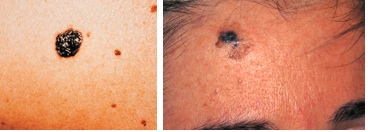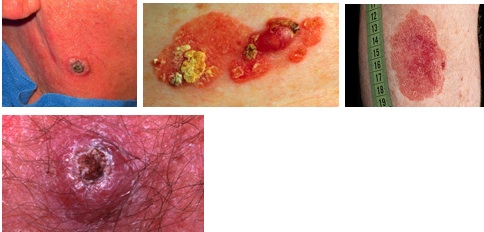Skin cancer from tanning
Skin cancer from tanning? Hah! not me....
Like many other good health practices in life, practicing safe tanning is perceived in the same vein as practicing safe sex. Just as so many people just don't believe they will be the one to get AIDS, many people also don't think about skin cancer affecting them when out enjoying the wonderful sunshine. I will not be the one!
Even when the odds are stacked against you, with a long family history of skin cancer, people ignore the warnings and keep on tanning.
The most common cancer is quite surprisingly not lung, breast, prostate or colon. Skin cancer wins by far! The stats tell us that for every 5 people in the US, there will be one affected with skin cancer during their lives.
Skin cancer not only beats all of these, it occurs higher than all of them combined!
Diagnosing skin cancer from tanning
Even though skin cancer is predominantly easily diagnosed, thousands die from it every year. This is mostly from not having it diagnosed until too late for effective treatment.
Yet it is actually very easily detected if you just pay attention to the warning signs. The following are the 3 basic types of skin cancer and what to be aware of:
1. Basal Cell Carcinoma - most common skin cancer from Tanning
 Basel cell carcinoma skin cancers
Basel cell carcinoma skin cancersThe most common of skin cancers in humans, it is also the least deadly. It is also predominantly and indisputably caused by too much exposure to the sun's UV rays. Way too much tanning is a common cause.
It rarely, if ever, metastasizes, but can be very disfiguring as it invades the localized skin area, quite destructively. If you leave them unattended long enough, they can destroy the surrounding tissues to such an extent that you have no ear or nose left, including muscle and nerve tissues.
Identified sometimes as just a pimple to start with, they can be seen as small rounded lumps or modules, superficial and sometimes ulcerating. Because they are small and relatively normal looking, they can be difficult to detect, so again a regular visit to a dermatologist really does help if you feel you are at all vulnerable.
The main cause for basal cell carcinomas, as with all skin cancer from tanning, is overdoing the sun - too much ultraviolet exposure without being sensible!
2. Melanoma - most deadly skin cancer from tanning
 Melanoma skin cancers
Melanoma skin cancersThe least common, it is nevertheless the one that claims the most lives. Some statistics worth noting:
- Every hour in the US someone dies from melanoma
- 75% of all deaths from skin cancer are from melanoma
- Melanoma accounts for only 5% of the total number of skin cancer cases
Created from either of the following pigment-producing cell types:
- melanocytes - appear as if out of nowhere
- nevomelanocytes - starts within a nevus or mole already present and then changes
The signs of skin cancer from tanning to look for include:
- A: Asymmetry in shape
- B: Border irregularity
- C: Color variegation
- D: Diameter larger than 6.0 mm
- E: Evolution - an increase in size or change in shape over time
The latter sign is definitely considered to be one of the most important signs of a malignant melanoma.
The risk factors for melanoma are a little contentious at the moment. For many years we have all been told by such organizations as The Skin Cancer Foundation, The American Cancer Society, The American Academy of Dermatology, and The Skin Cancer Foundation of Australia, plus dermatologists and doctors that too much of the sun's damaging UV rays are the main culprit causing melanomas. More recently however, we are being told that in fact Vitamin D created by the sun's UVB rays through our skin, plays a huge role in helping us to fight skin cancer from tanning.
However, it does appear there is a relatively easy way to deal with both of the above:
- Get 10 - 20 minutes exposure to the midday UVB rays once a day if you can in order to create about 5000 IU's of Vitamin D, which is what is recommended as a healthy daily dose
- Don't ever overdo the sun and let yourself get sun burnt. This applies to the midday exposure for Vitamin D creation, as well as any time during the day
- Protect yourself from UVA exposure through the use of a sunscreen that contains high UVA protection as well as the usual UVB protection. Preferably choose a sunscreen that is natural with organic ingredients and therefore non-toxic - non-chemical based, without any other cosmetic ingredients that are harmful, such as parabens
However, other risk factors for melanoma you need to consider and account for include your genetic background and whether or not you have fair skin and blue eyes and any family history of skin cancer and especially melanoma. Another aspect to note is an increase in the number of moles on your body or the appearance of any new ones.
If any of the above applies, visit a dermatologist to have a skin exam regularly. Skin cancers from tanning are being diagnosed from the teenage years onwards, but predominantly from 30 - 50, so if you're concerned, be sure to see your dermatologist or doctor.
3. Squamous Cell Carcinoma - 2nd most deadly skin cancer from tanning
 Squamous cell carcinomas
Squamous cell carcinomasAfter melanomas, squamous cell carcinomas are the second most deadly as well as being the second most common form of skin cancer from tanning. They result in as many as 2,500 deaths in the US every year. They are very destructive in their localized state, but beyond this have potential to metastasize to other organs in the body and eventually can even cause death.
In their precancerous state, the lesion is known as an actinic keratosis and is identified as pink to red, mostly scaly and either solitary or in multiple clumps. They are quite superficial skin surface lesions that if left untreated can spread to other organs and ultimately even cause death.
Predominantly caused through UV ray exposure, they are relatively easily contained through the use of sunscreens or careful exposure to UV rays from the sun or from tanning booths.
Safe Tanning Conclusion
The following are considered to be essential habits for tanning safely and avoiding skin cancer from tanning:
- Protect yourself from too much sun
- Be aware of the health of your skin and any changes in your skin
- Visit your dermatologist regularly




New! Comments
Have your say... please leave me a comment in the box below.